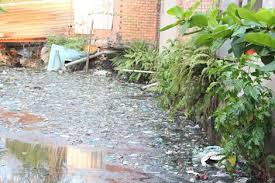

The 70 houses in the poor village located on a small alley of TMT13 road keep their doors shut because of the terrible odor from the canal.
The canal is known as a destination for garbage sourced from everywhere. Locals often appear on TV complaining about the pollution and newspapers have reported the problem again and again.
Domestic garbage can be seen everywhere in the village, from organic waste to plastic bags.
The village is very quiet, because no one can stay outside. Children are told by their parents to stay inside their houses or they may catch disease because of mosquitoes and bad odors.
“Gia Dinh is no longer a canal. It is now just a place for people to drop litter and for mosquitoes to reproduce,” said an old man, who was playing chess with another when reporters visited.
Most of the local residents are from the north, while some are workers at nearby factories.
“The canal has been choked to death,” the man said. “It has been poisoned by people who throw waste into the canal every day.”
“Gia Dinh canal has been the ‘black water canal’ since the day it died,” he added.
HCM City authorities and environmentalists have many times tried to revive the canal, but have failed.
Workers from the city’s environment and urban area development company and university students sometimes pick up waste from the canal bed during voluntary campaigns.
However, their efforts have been in vain. The canal become full of garbage within several days as people continue to drop litter into it.
Locals lack clean water and are concerned about mosquitoes.
The polluted canal has seriously affected the underground water. Locals have to buy tap water from other localities for daily use, while they dare not use water from wells. They have to eat their meals under mosquito nets in the rainy season, and live in the fear they may catch dengue fever.
In related news, the second phase of the project on cleaning the Nhieu Loc – Thi Nghe Canal in HCM City, has started. With the expected cost of $450 million, the project will focus on restoring and protecting the ecosystem of the Sai Gon River and the lower course of the Dong Nai River in addition to upgrading the urban area face.
PL TPHCM